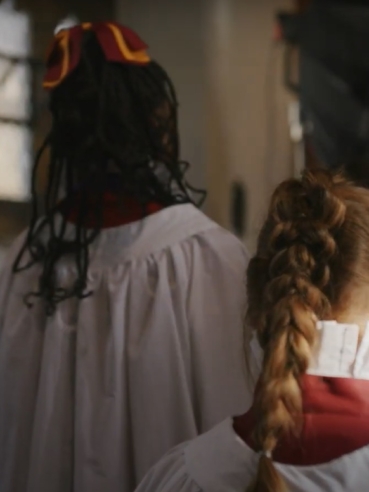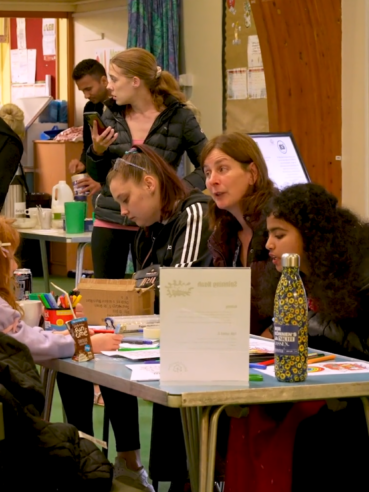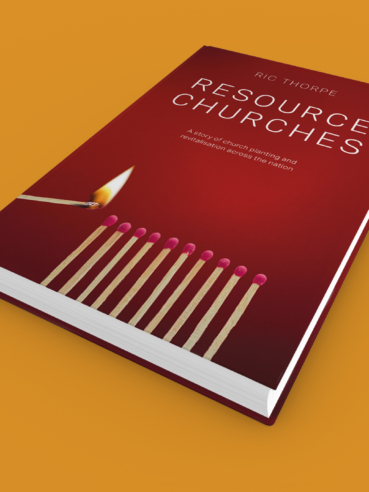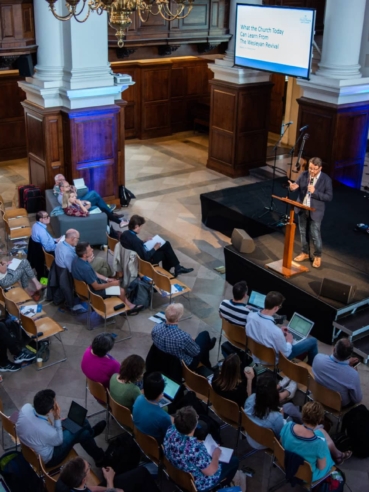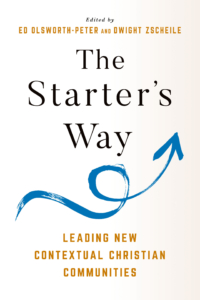 Edited by Dwight J. Zscheile and Ed Olsworth-Peter, The Starter’s Way encourages churches to meet people where they are; a starter church can be small, adaptable and set in a coffee shop, a school gym, a park pavilion, or even online. At the heart of the starter church model is the notion of contextual community – a congregation shaped by a particular place and the people it serves. A contextual community might gather in a local bar to talk about faith over live music, or host bilingual services and cultural celebrations in an immigrant neighborhood.
Edited by Dwight J. Zscheile and Ed Olsworth-Peter, The Starter’s Way encourages churches to meet people where they are; a starter church can be small, adaptable and set in a coffee shop, a school gym, a park pavilion, or even online. At the heart of the starter church model is the notion of contextual community – a congregation shaped by a particular place and the people it serves. A contextual community might gather in a local bar to talk about faith over live music, or host bilingual services and cultural celebrations in an immigrant neighborhood.
Read on for an extract of this encouraging, resourcing work:
We’re now more than twenty years into the most recent movement toward starting new Christian communities in the United Kingdom and the United States, and it’s helpful to take stock. In the United Kingdom, many initiatives, funding streams, and strategies have been launched, with some success. Since the publication of the Mission-Shaped Church report in 2004 in the United Kingdom, thousands of experimental contextualized Christian communities have been started within the Church of England, the Methodist Church, and other denominations. The pioneer and fresh expressions movement has seen a range of contextualized local forms of Christian mission and ministry launched and authorized. Many of these are small-scale and local, responding to a social need or to the recognition that there are people in the surrounding community who won’t step through the doors of a mainstream church. Although there has been official authorization of ordained pioneer ministers who have been selected, trained, and deployed, these roles have been hard to sustain financially, are currently given less prominence by dioceses, and it seems are diminishing in numbers. Therefore, most pioneers are lay people, starting local things in the communities in which they already live.
Bishop Ric Thorpe, bishop for church planting in the Church of England, identifies some useful reflections from an attractional approach to starting new Christian communities in the United Kingdom. In conversation with us he shared that the newest generation of church planters are not consumed with labels or differences with pioneers. The Pioneer Spectrum has helped to affirm the missional impulse that unites various approaches to starting new things that complement one another. He also identified that a change mandate has been shown to be essential in planting something within a church that is in need of renewal. Over the past decade “resource churches,” who are called to plant and revitalize again and again, have grown in number, with many having been supported from national church strategic funding. Dioceses are recognizing this vocation and enabling them to do this as much as they can. Lastly, the attractional church-planting movement has seen the rise of lay-led planters, which is beginning to gain acceptance, opportunity, and practice.
New global-majority ethnic congregations have brought the spiritual vitality and dynamism of world Christianity into Britain, now accounting for the majority of church attendees in major cities such as London. Christianity’s present and future are diverse, highlighting the increasing need to grow bicultural and multicultural new contextual Christian communities. The paradigm of a “mixed ecology of church” of inherited and new forms of Christian communities thriving alongside each other has provided a fruitful conceptual framework to affirm the importance of time-honored forms of church and to make space for emerging ones.
The US landscape of new Christian communities reflects significant regional and ecumenical diversity. Much church planting remains attractional in nature, focused around the launch of a worship service. This continues to work to reach some people disconnected from church participation, typically who have a previous church background (which is more commonly the case in the United States than western Europe). Many of these church plants follow similar patterns of contemporary worship and small groups. As with the United Kingdom, new immigrant communities and communities of color represent a growing presence within the new church landscape, many with a charismatic flavor. Alongside this has emerged a new wave of fresh expressions of church, microchurches, and other contextualized new communities focused first on neighborhood engagement, community formation, and hospitality, along with spiritual exploration and discipleship. These communities tend to be centered around tables rather than stages. Different continents have had different experiences depending on the state of Christendom’s decline, but some common themes are emerging.
First, we want to note the variation internationally in the language used to describe new Christian communities and their leaders. Some prefer “planting” and “planters” as a catchall, encompassing various approaches. Others may want to nuance this further. Our book The Starter’s Way focuses specifically on the process of contextual mission and ministry. This is the process of living incarnationally within the local landscape and, by making connections and relationships with the people there, starting a new form of church collaboratively by asking, “What would church look like for us together in this place?” In this sense, each new Christian community will be unique. Modern Western culture tends to perpetuate cookie-cutter approaches, often without adequate attention to local context. Contextual mission is different.
In the United Kingdom, the language of “pioneer” and “fresh expressions” has been used to describe this process. The Church of England defines pioneers as “people called by God who are the first to see and creatively respond to the Holy Spirit’s initiatives with those outside the church; gathering others around them as they seek to establish a new contextual Christian community.” The term draws on Hebrews 12:2, where Jesus is described as the “pioneer and perfecter of faith.” While the term “pioneer” is sometimes also used in the United States to refer to starters of contextual Christian communities, many prefer alternative language. “Pioneer” can have problematic historical resonances, as it is associated with European colonization of the American West and the accompanying Native American genocide. The language of “planting” can be used as a generic term which describes any kind of new Christian community, which is the case in the United States and increasingly so in the United Kingdom. The contributors to The Starter’s Way will use a variety of language relevant to their setting but all are writing from a contextual approach and perspective.
One of the key learnings of contextual mission and ministry so far is that it is hard work! Many stories from practitioners show that there are no easy shortcuts to starting and leading a contextualized new Christian community. Sustaining them can be even harder where new communities are fragile, lack income and ample local leaders, and where support from the wider church is (or feels) absent. Anecdotally, it is said to take five or more years to grow a contextual community and longer for it to mature. Fatigue and burnout have been a sad reality for some in Western cultures where there is a strong emphasis on quantifiable or controllable outcomes. Sometimes expectations placed on leaders for what the community should look like if it is “successful” do not fit what God wants to do in a particular context. Starters have shown they need to root themselves in deeper spiritual foundations to give them stamina for the long haul.
Starting contextualized new Christian communities is a marathon, not a sprint. The theology of new Christian communities is still developing, with more work needing to be done.
Excerpt reprinted with permission The Starter’s Way ©2025 Church Publishing Incorporated, New York, NY 10016

 Edited by Dwight J. Zscheile and Ed Olsworth-Peter, The Starter’s Way encourages churches to meet people where they are; a starter church can be small, adaptable and set in a coffee shop, a school gym, a park pavilion, or even online. At the heart of the starter church model is the notion of contextual community – a congregation shaped by a particular place and the people it serves. A contextual community might gather in a local bar to talk about faith over live music, or host bilingual services and cultural celebrations in an immigrant neighborhood.
Edited by Dwight J. Zscheile and Ed Olsworth-Peter, The Starter’s Way encourages churches to meet people where they are; a starter church can be small, adaptable and set in a coffee shop, a school gym, a park pavilion, or even online. At the heart of the starter church model is the notion of contextual community – a congregation shaped by a particular place and the people it serves. A contextual community might gather in a local bar to talk about faith over live music, or host bilingual services and cultural celebrations in an immigrant neighborhood.

